Serving hundreds, even thousands, of people during an event is a challenge in itself: timing everything perfectly, ensuring the plate is beautiful when it leaves the kitchen, and above all, it must be delicious. But let’s make it more interesting. Let’s put you into a small kitchen that is constantly—literally—moving and eliminate the opportunity to triage missing ingredients, equipment, or even vessels with a quick dash off site. Sound intimidating? Well, that is exactly the world that caterers encounter while working on cruise ships and yachts.
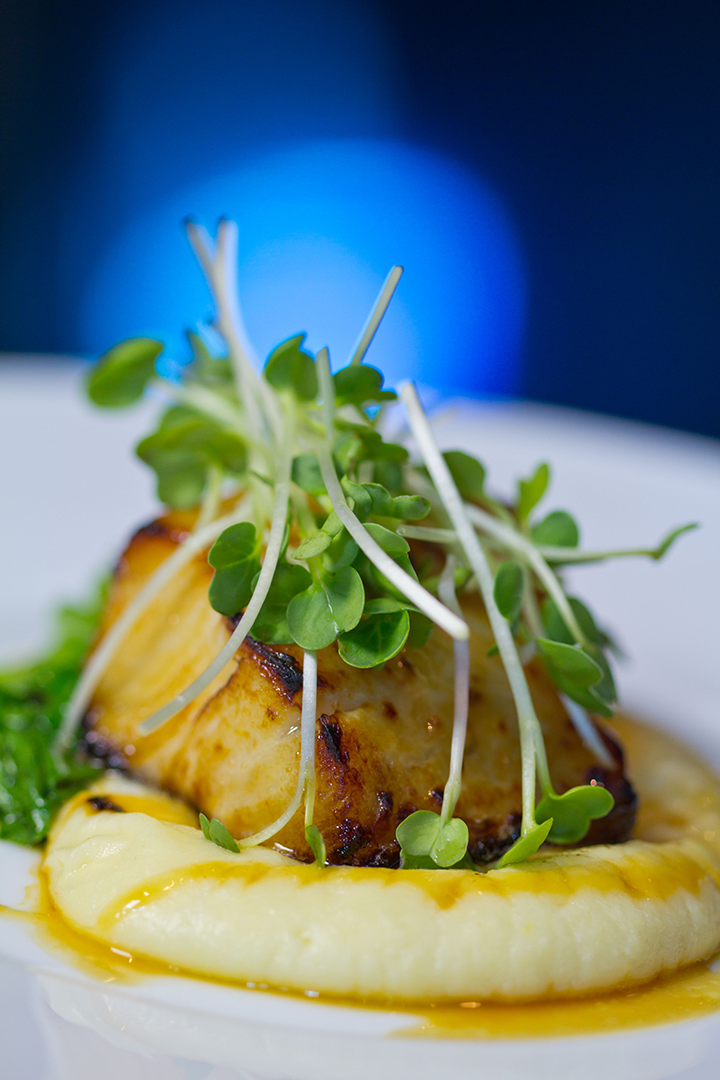
Mahogany black cod aboard Royal Caribbean. Photo courtesy Tim Aylen
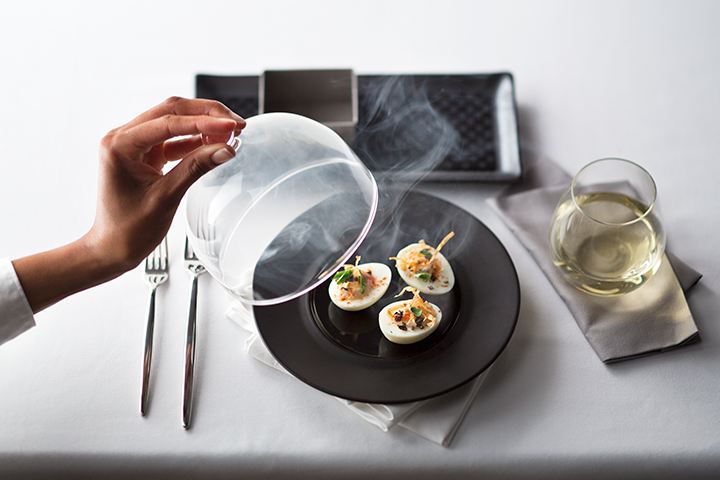
The Bird’s Nest (at Royal Caribbean’s Wonderland) is a deviled egg that has been smoked and is served with blue cheese and hot sauce.
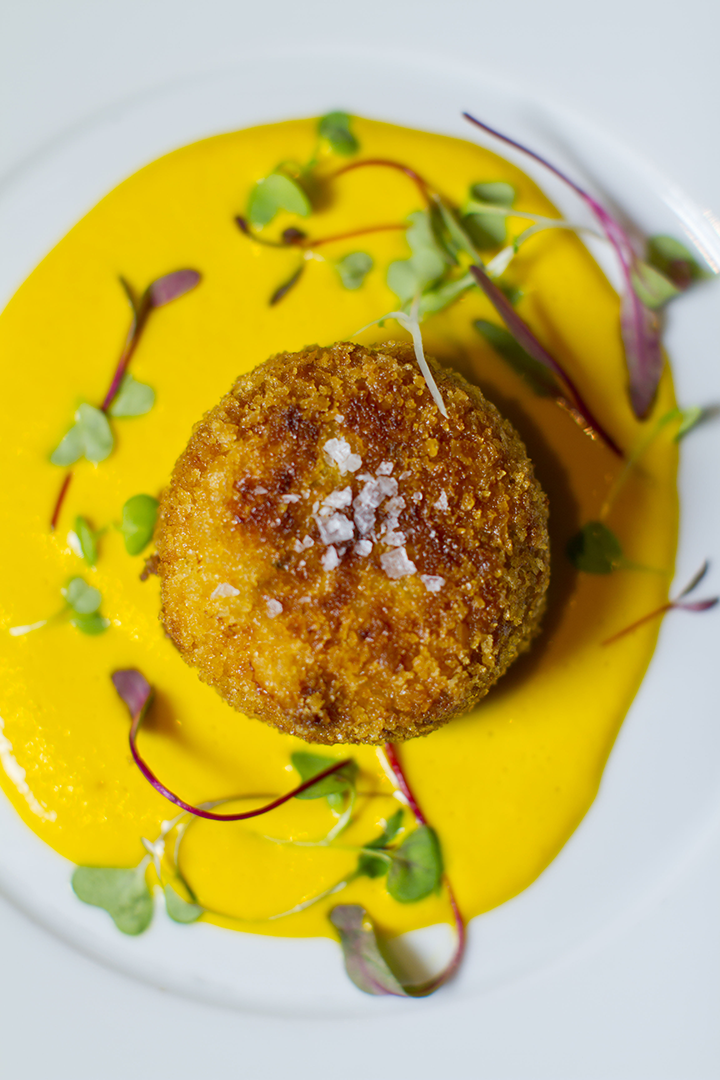
Jumbo lump crab cake aboard Royal Caribbean. Photo courtesy Tim Aylen
“As a primarily off-premise caterer, we embrace the crazy that comes with catering on the water!” says Robin Selden with Marcia Selden Catering & Events, which has a division of its business (Maritime Club) that specializes in serving on private yachts.
Life onboard
The first step in catering aboard a ship is recipe and menu development, which will often occur in test kitchens in port. For example, Royal Caribbean’s chefs utilize a test kitchen in Miami where they can experiment with different recipe ideas.
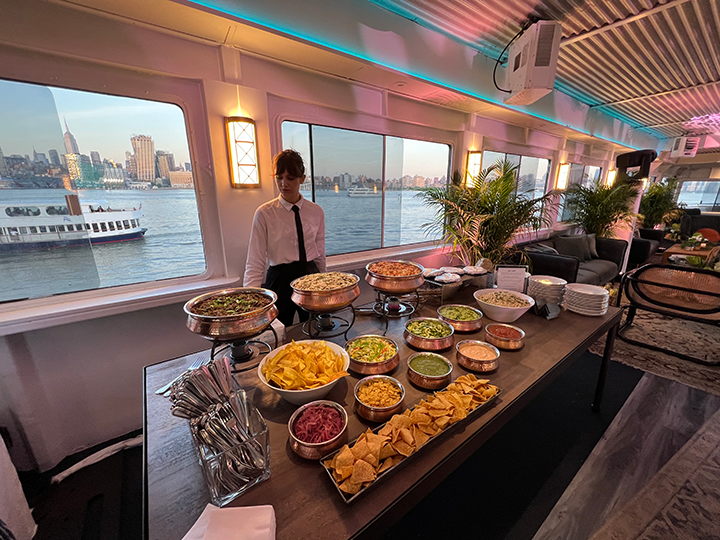
Marcia Selden Catering & Events sets out a buffet aboard one of their Maritime Club’s clients’ private yachts. Photo courtesy Marcia Selden Catering & Events
“The test kitchen is crucial because we can take it from a small idea and we can recreate that small idea in a small environment—It’s much better to start things small in order to test them,” said Gary Thomas, Corporate Executive Chef for Royal Caribbean in a Royal Caribbean promotional video. “This is where we play, this is where we work.”
The dishes that are developed in test kitchens are oftentimes then tried out onboard in a ship’s specialty restaurants or as a daily special. If it is a popular item, it will then be put into the regular menu rotation.
“The ultimate decision maker is our guests,” said Michael Gilligan, Director of Culinary for Royal Caribbean, in the promotional video.
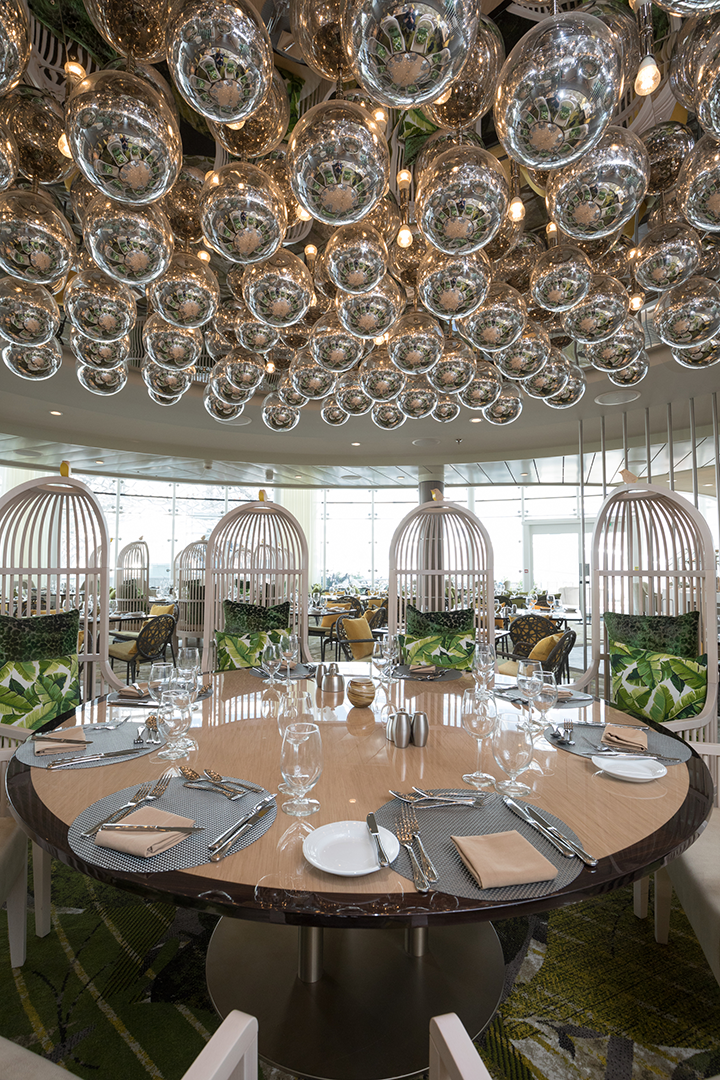
The Solarium Bistro (aboard Royal Caribbean’s Symphony of Seas) serves as a buffet during the afternoons, but transforms into a reservation-only, specialty restaurant in the evening. Photo courtesy SBW-Photo
Okay, so the menus are set and it’s time to get onboard. Load-in day for a weeklong cruise consists of pallets upon pallets of food being loaded into the ship’s galleys (or kitchens) where the nearly 300-person kitchen crew will get to work creating meals for the roughly 10 restaurants and buffets onboard. Each item is carefully inspected by the culinary crew to ensure that all perishables are of the highest quality. On average, F&B staff (including chefs) work between 10 and 12 hours a day (seven days a week) since there is usually some sort of food available 24 hours a day (even if it’s just room service).
“The most unique part of working on a boat is the timing and precise planning as there is no room for error,” Selden says. “You can’t run out and grab something that may have been forgotten once you’ve left the shore.”

Marcia Selden Catering & Events’ staff is dressed to impress aboard one of their Maritime Club’s clients’ private yachts. Photo courtesy Marcia Selden Catering & Events
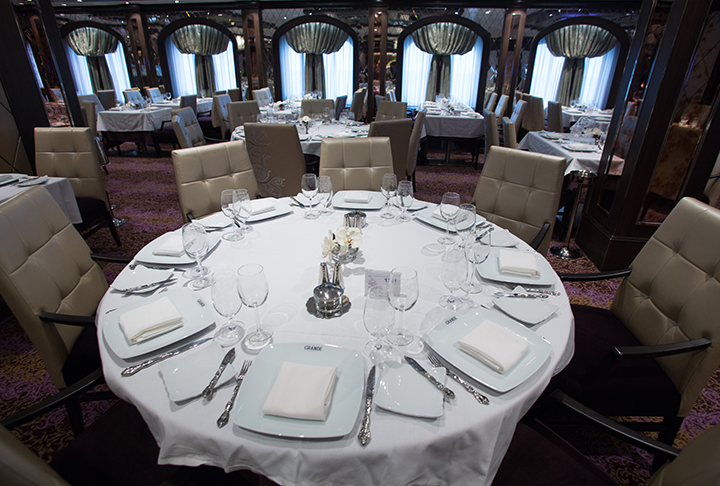
The height of contemporary cuisine is realized at Chic (one of the main dining rooms) onboard Anthem of the Seas. Photo courtesy SBW-Photo
For example, there have been plenty of instances of a vendor or supplier getting delayed and missing the ship, so it is then their responsibility to get the food on the ship, whether it’s by helicopter, boat, seaplane, or at the next port of call.
Next, it’s time to train the galley staff, and many cruise lines will offer in-house training onboard for new crew members.
So, we’re ready to serve now right? Almost. First, each member of the culinary team is assigned to one of the galley stations where they work in tandem to prepare meals.
“Everybody has a specific job, and they have to know it inside and out,” says Rick Welch, longtime executive chef and president of RMW Global Consulting. “It’s this idea of divide and conquer.”
It is also important to account for the small kitchens, narrow stairwells, elevators, and hallways.
So, the menus are planned, the food is loaded, the staff is trained, and everyone has their job. All that’s left is to hit the stage.
“When you go out these doors, it’s showtime,” says Welch (who is a collaborator with Seatrade Cruise Global, which will be delivering a new conference on cruise dining called F&B @ Sea). “You’re preparing to deliver a service that is legendary.”
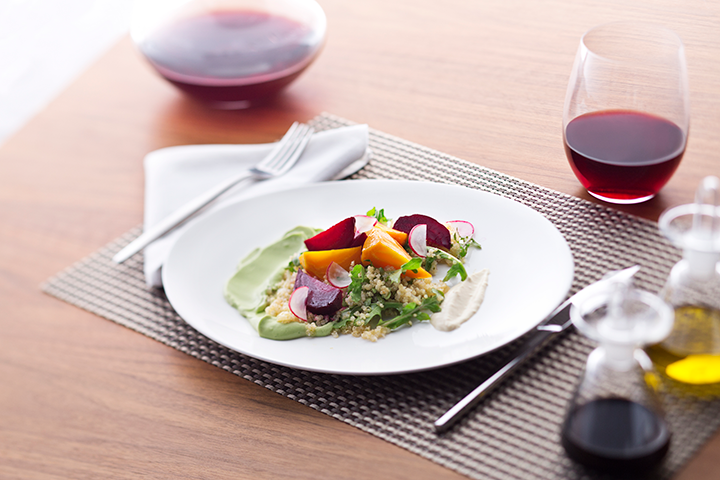
Coastal Kitchen (aboard Royal Caribbean) fuses Mediterranean influences with the unmatched riches of California’s bountiful farmlands and features such dishes as the Golden Beet Salad.
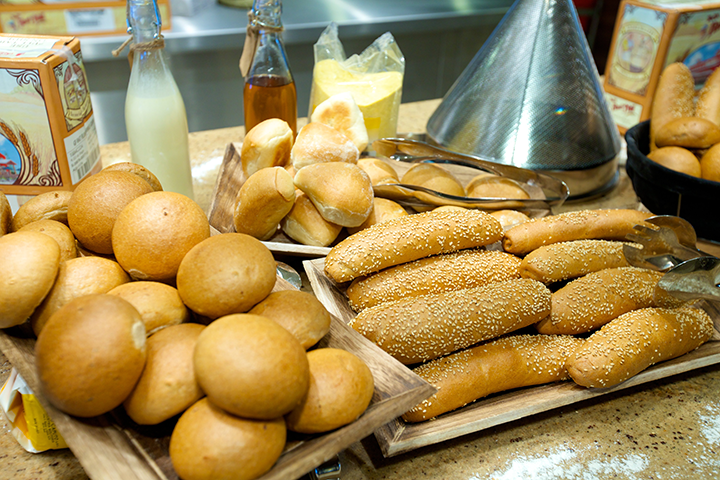
Fresh baked bread is prepared daily aboard most cruise ships.
One of the biggest undertakings on any cruise ship is the buffet, since it will be set for the three traditional pockets of time: breakfast, lunch, and dinner. Not surprisingly, the cruise staff is such a well-oiled machine that the flip is near seamless. “From soups to nuts, it’s only about 45 minutes to an hour-and-a-half to flip it,” Welch says. “We have all-hands-on-deck and we divide and conquer—it’s a symphony of chaos.”
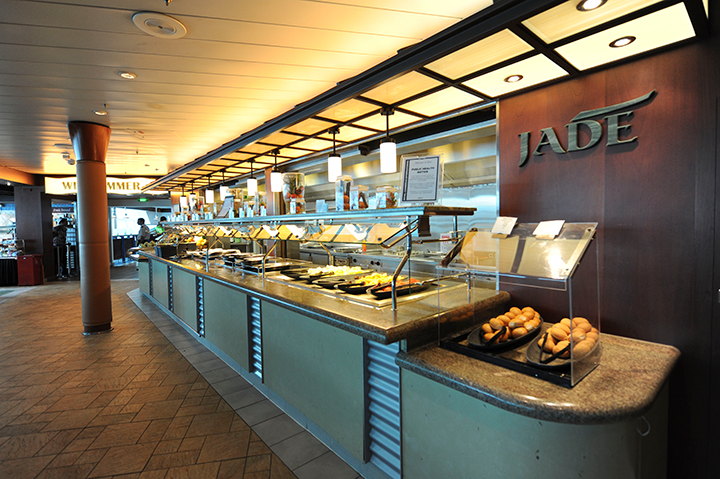
The Windjammer serves as the main buffet aboard Royal Caribbean ships and features international dishes including scrambled egg Bhurji served with roti, home-style crispy chicken and waffles, watermelon and feta salad, traditional chicken marsala, savory pork vindaloo, tangy duck a l’Orange, and flavorful Caribbean goat curry. Some days, the Windjammer will have a themed menu.
Want to know one of the secrets to such seamless service? “There are conveyer belts everywhere and specialized delivery mechanisms,” Welch says.
“Also, checklists are king when you work on a cruise ship. Everything is such minute detail because you’re in a foreign environment when you must travel,” he says. “It’s an amazing thing what they do on board to produce what they produce.”
In the galley
The story of each onboard meal begins with reservations and sales, where ship operators can understand the type of clientele they are expecting on each cruise. For example, a Disney Cruise Line ship may have a lot of chicken nuggets and pastas since so many of the passengers won’t have very sophisticated palettes (children). Or if there is an overabundance of British guests, for example, be ready for roast dinners and puddings for dessert. Guests from continental Europe crave more Mediterranean-style dishes that feature fresh seafood and desserts with fruit, according to the American College of Culinary and Language Arts.
“In the main dining room there are dishes you cannot get rid of (like French onion soup or escargot),” said Gilligan. “But we want to try and do those old classics, just with a little twist.”
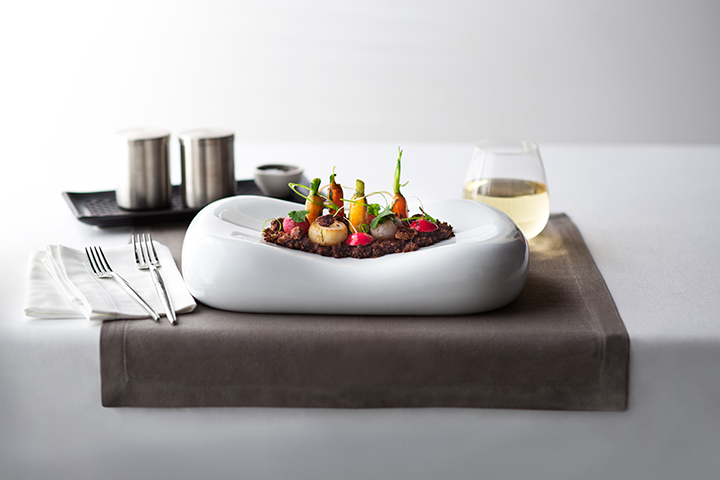
The Baby Vegetables in the Garden (served at Royal Caribbean’s Wonderland) come with edible pebbles and soil.
Since cruise ships sail from ports all around the world, and attract people from all nationalities, dining menus will have to accommodate all different types of appetites and tastes. However, a simple rule of thumb is fresh, delicious, and authentic cuisine.
“To come up with new menu items for the main dining room is a collaboration, it is an amalgamation of all of those great ideas coming together,” Gilligan said.
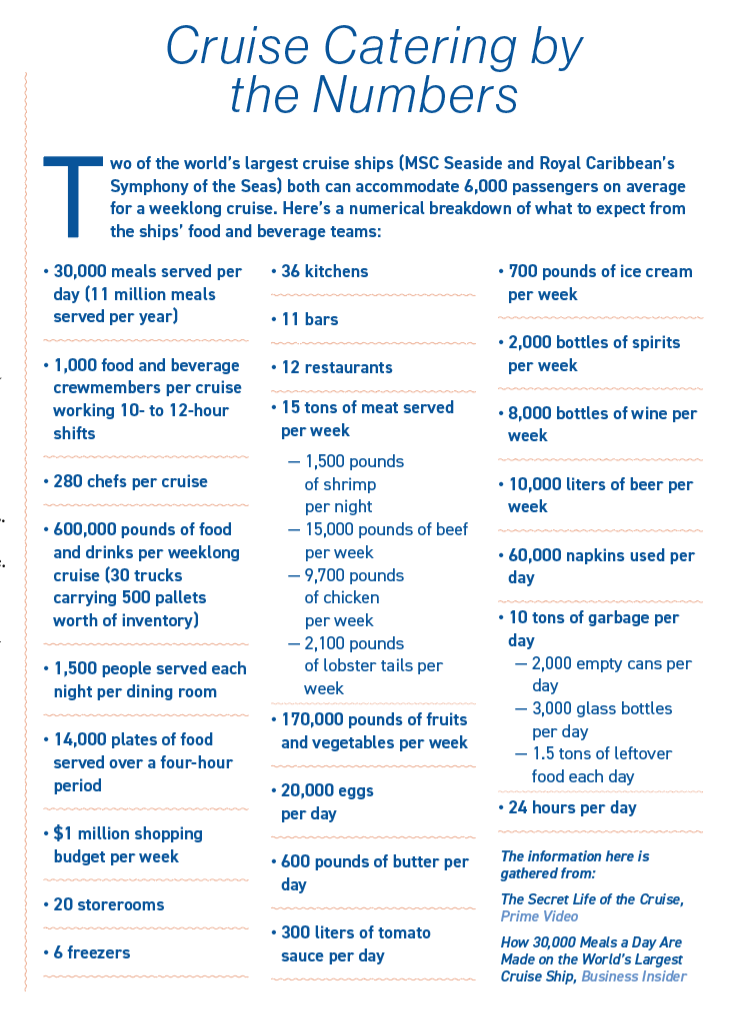
The information here is gathered from: The Secret Life of the Cruise, Prime Video | How 30,000 Meals a Day Are Made on the World’s Largest Cruise Ship, Business Insider
On Royal Caribbean’s Ovation of the Seas, some of the menu options include: slow-roasted prime rib (tender beef with potato croquette, broccoli, and horseradish au jus), baked polenta and feta cheese (creamy corn polenta, feta cheese, crispy grilled vegetables, olive oil, and balsamic vinaigrette), pumpkin soup (silky pumpkin soup, sour cream, toasted pumpkin seeds, and crispy bacon), duck l’orange (roasted marinated duck legs, with croquette potato, braised red cabbage, and orange Cointreau sauce), and Moroccan-spiced ahi tuna (grilled tuna steak served over mint couscous, sauteed spinach and tequila peppers, topped with yogurt vinaigrette).
For Marcia Selden Catering & Events, their at-sea menus rely on simple dishes.
“You need to plan menus that are easy to manage in very tiny quarters,” she says. “The galley on most yachts is the size of a closet with limited counterspace and small refrigerators. We make sure that even the way we pack the food to get on board is important. It needs to be done as compactly and organized as possible as there isn’t typically even storage for the Cambros, boxes, hand trucks, etc. that you would typically use to load your food and equipment for an off-premise event.”
Many cruise ships will also utilize “secret menus” that guests can order from (if they’re in the know). Oftentimes, galley chefs will produce globally inspired dishes for the ship’s crew (since so many are international) so that they can feel at home. Many of the chefs are also international themsselves, so this allows them to highlight their own specialties that may never appear on the printed dining room menus. Some of the secret menu items often found on cruise ships include curry and other traditional Indian dishes, adobo, jerk chicken, fried rice, kosher items, Italian, and in many cases their own family recipes.
Sustainability at Sea
One would think that something such as cruise ships, with so many people onboard, would accumulate mountains of waste. However, it’s just the opposite. Cruise ships incorporate myriad sustainable practices to ensure they leave the oceans as pristine as they found them.
According to The Secret Life of the Cruise (on Prime Video) a cruise ship can accumulate about 10 tons of garbage during a weeklong cruise; however, 80% of that can be recycled. While onboard, the crewmembers who work in the ship’s garbage room meticulously sort the day’s garbage by hand, after which it goes to either the incinerator to be disposed of, or to the compactor for processing. Once the ship returns to port, it can then transport plastic, aluminum, paper, and glass for recycling.
The biggest contributor to a ship’s waste is obviously the food. Fortunately, cruise operators have become so precise with their food ordering that there is very little leftover food at the end of the cruise, which means the majority of the food waste comes from what’s left on passengers’ plates. On average, there is about 1.5 tons of food waste every day aboard a cruise ship, which equates to enough food to feed another 500 passengers, according to The Secret Life of the Cruise.
As a way to sustainably deal with the waste, the leftover food is pulverized and puréed and held in large holding tanks until it can be discarded in open sea, where it can serve as fish food.
Another alternative that many cruise ships are utilizing is an onboard “food cycler” where organic food waste can be transformed into high-grade soil or fertilizer, according to Cruise Deals Expert.
Another initiative that has generated some buzz among the cruise industry is Viking Cruise Line’s conversion of food waste into biogas. Through a partnership with Envor Group, the ship’s biowaste is collected at port in Helsinki and is then transported for processing. Envor then transforms the waste through a biogas purification process, which results in biogas that is suitable for vehicles. According to Viking Cruise Line’s 2020 Sustainability Report, Viking brought a total of 470 tons of food waste ashore from Viking XPRS, Viking Grace, and Mariella for biogas production. This yielded 35,230 cubic meters of biogas, equivalent to 39,800 liters of petrol.
The chefs themselves also play a pivotal role in reducing food waste by adjusting their menus accordingly. For example, if produce is ripening faster than expected, they try to work it into another meal, such as overripe broccoli going into broccoli cheddar soup instead of being tossed.
Row the boat
One of the most unique things about working on a cruise ship or yacht is the unpredictability. “The ship is rocking and at any moment if somebody didn’t put the break on a trolley, you’re going to see that trolley flying away,” said Allan Gentile, Development Chef of Culinary Innovation & Operation, in How 30,000 Meals a Day Are Made on the World’s Largest Cruise Ship, a Business Insider video. “It happens.”
However, today’s ships are built with stabilizers underneath to help safeguard against unruly seas. Additionally, most cruise lines will have a meteorologist on staff who can advise captains to head into port in case the seas really get out of control.
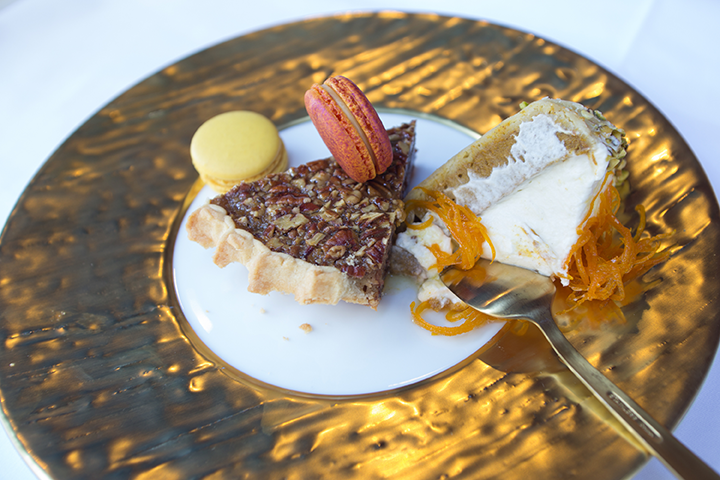
Chefs who work aboard Royal Caribbean have the opportunity to experiment with new flavors and presentations in order to wow guests. Photo courtesy Simon Brooke-Webb
However, it is important to make sure that everyone on staff has their sea legs. “We always get anti-nausea bracelets for our team to wear at events,” Selden says. “If you’ve been on a boat, sea sickness can hit and that is no fun when you are having to work!”
So, what happens if you run out of an ingredient mid-cruise? Well, there is always the option to pick up items in the next port of call, but most often it’s on the chef to be creative.
“When you’re talking about culinarians, the mind of a culinarian is almost James Bond-ish,” Welch says, “you always have to have plan A, B, C, D, E, and F.”
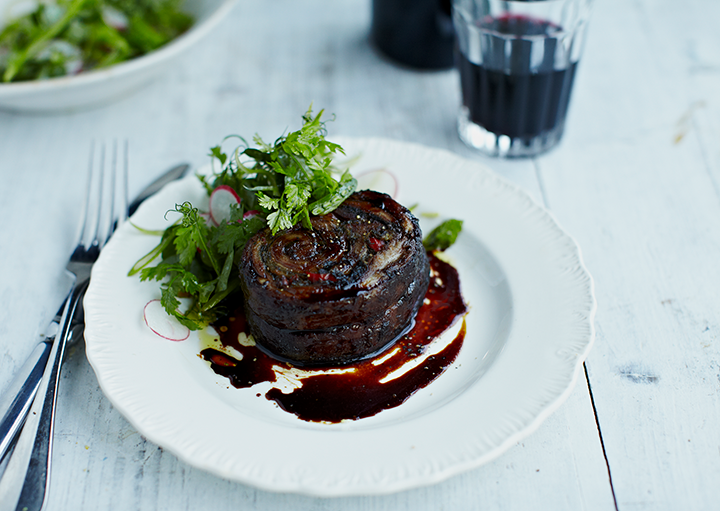
Jamie’s Italian by Chef Jamie Oliver features such favorites as his famous lamb.

Milk chocolate cremoso aboard Royal Caribbean. Photo courtesy Tim Aylen
How about if there is a power outage onboard? All freezers and refrigerators have backup battery-powered generators to safeguard against spoiled food.
One of the most recent situations was several years ago when a Carnival Cruise Line ship encountered engine trouble and was stranded at sea far beyond their food reserves. The solution? A helicopter delivered fresh food to restock the galleys (most cruise ships are equipped with helipads).
“These things happen and for the most part guests understand,” Welch says. “You try to prepare the best you can, but you cannot prepare for everything.”
Trends ahoy
Just like any other area of catering, trends often play a key part in dining onboard. For example, Royal Caribbean has fully embraced the plant-based movement by having a vegan menu option as part of their main dining menu. Virgin Cruises has embraced the trend so full-heartedly that they not only have plant-based items on their main dining menus, but they also have a vegan-specialized restaurant (Razzle Dazzle) that serves such options as mushroom tartare and banana blossom “fish” and chips.
Another popular trend in cruise dining is the celebration of regional dishes and local ingredients. On a recent Alaskan cruise on Royal Caribbean’s Ovation of the Seas, the final evening’s meal featured a special Canadian menu (as the port that day was Victoria, B.C.) featuring fresh Canadian sockeye salmon with a maple drizzle, and a maple souffle with bourbon caramel for dessert.
Experiential dining is also becoming increasingly popular aboard cruise ships. One of the most famous is Wonderland, an Alice in Wonderland themed restaurant aboard many of Royal Caribbean’s ships where “chefs twist their culinary kaleidoscopes to invent an elaborate dreamscape of never-before-seen fare” such as: “liquid lobster,” “liquid risotto,” a side of vegetables served in a garden of edible dirt, a dessert that implodes before your very eyes, and a cosmopolitan that is poured over raspberry cotton candy.
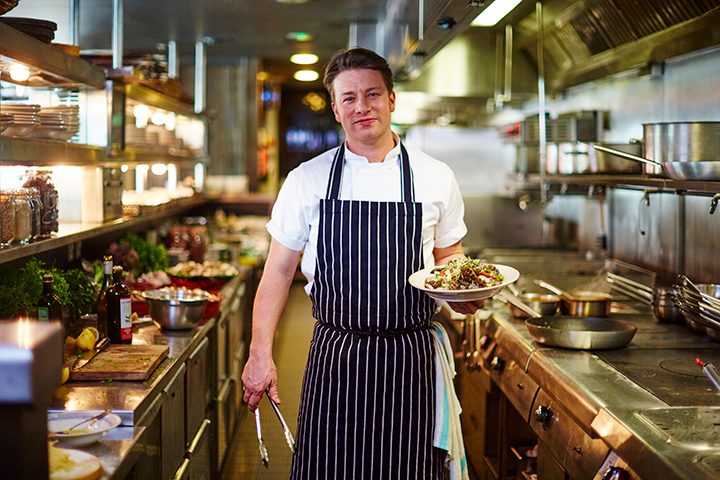
Cruise lines commonly partner with celebrity chefs for onboard specialty restaurants. Jamie’s Italian by Jamie Oliver (aboard most Royal Caribbean ships) features handmade rustic Italian favorites using seasonal ingredients and Jamie’s tried-and-true recipes.
Lastly, celebrity chef partnerships have almost become the norm on cruise ships with such restaurants as The Grill by Thomas Keller (Seabourn Cruises), Asian Market Kitchen by Roy Yamaguchi (MSC Cruises), Jamie’s Italian by Jamie Oliver (Royal Caribbean), and Guy’s Burger Joint by Guy Fieri (Carnival Cruise Lines).
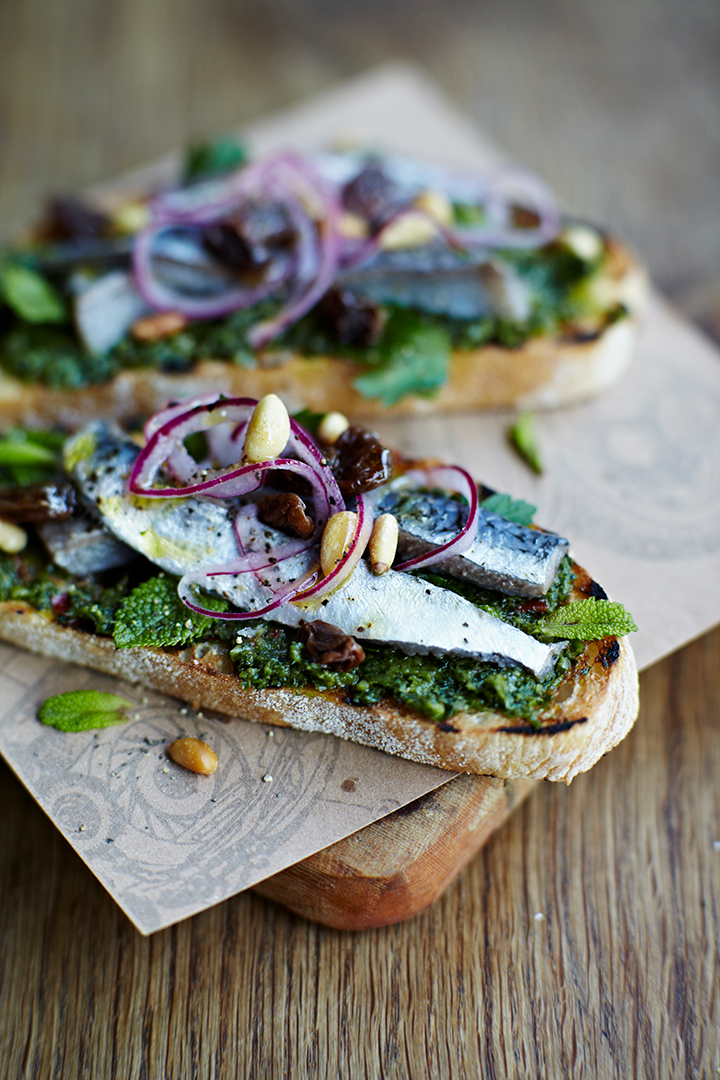
Jamie’s Italian by Chef Jamie Oliver (aboard Royal Caribbean) features rustic Italian favorites, handmade to create amazing flavor combinations such as his Sardine Bruschetta.
So, are you cut out for life out at sea? Chef Peter Howell (Executive Chef for Royal Caribbean’s Mariner of the Seas) shares his advice:
“It’s a great job and I’ve never left it. I’ve thoroughly enjoyed it and it’s been a passion,” he said during an interview with travel vlogger Alanna Zingano. “You need to seriously look at what’s involved, but essentially you get to work with others while having fun. You learn very quickly that it’s far different than a lot of other jobs. It’s hard work, so you have to be prepared to do that. But it does have great rewards.”
Welch agrees. “It’s not an easy thing, and it’s never the same thing twice,” but it’s fun as all get out,” he says. “But you have to jump in with both feet, you can’t just dabble a toe.”
Editor’s note: Seatrade Cruise Global is owned and operated by Informa, Catersource’s parent company.
All photos courtesy Royal Caribbean International unless otherwise noted



